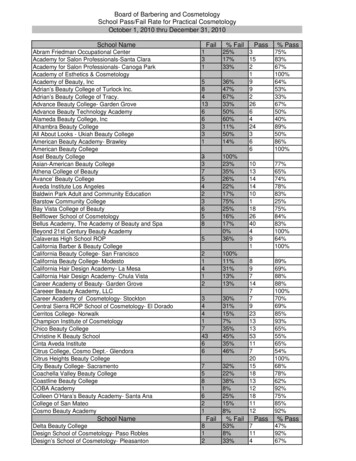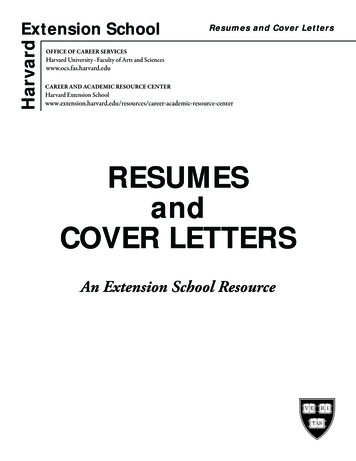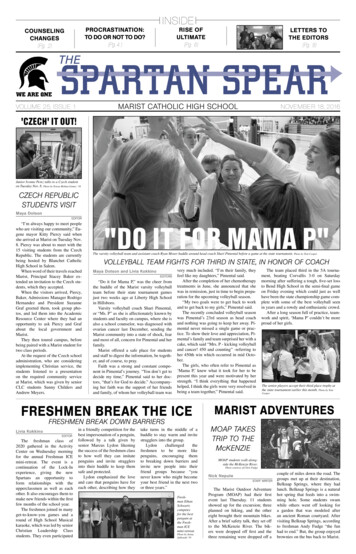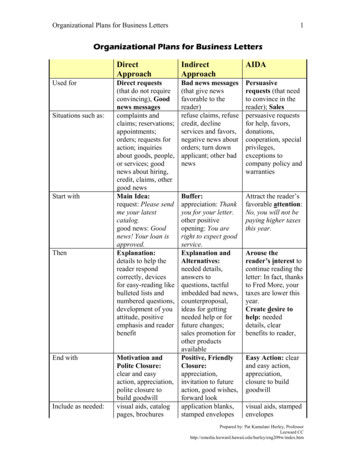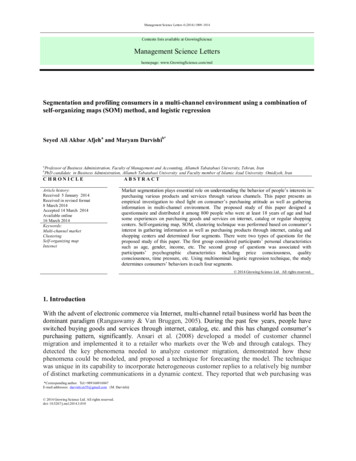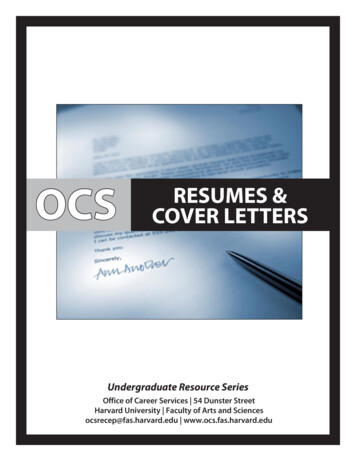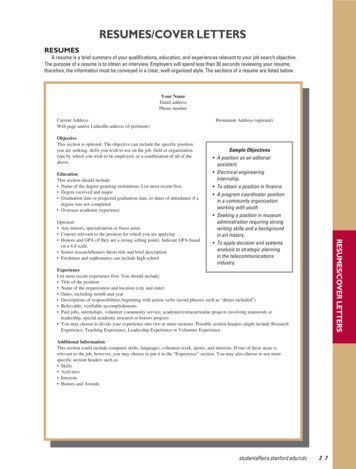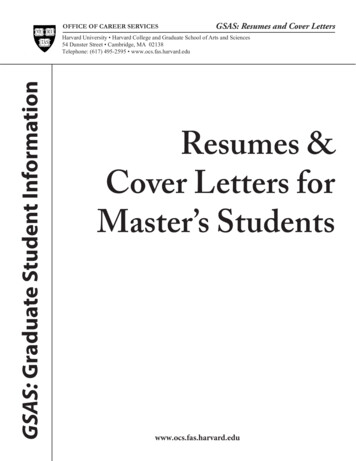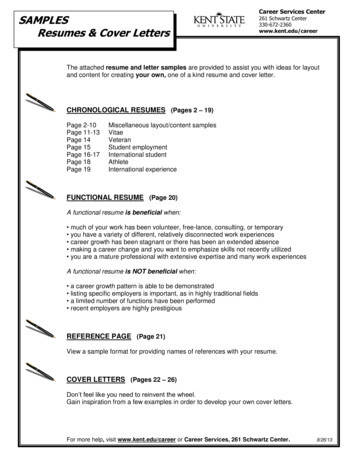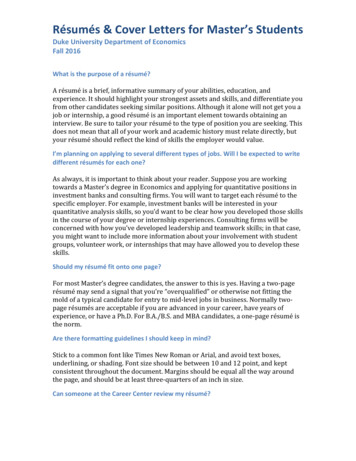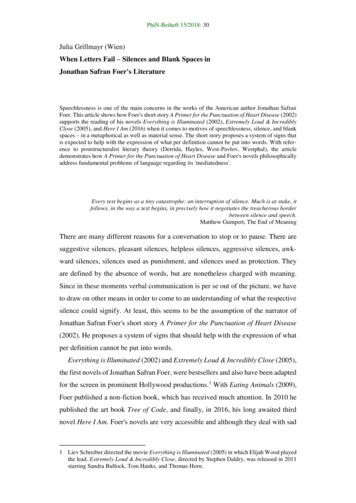
Transcription
PhiN-Beiheft 15/2018: 30Julia Grillmayr (Wien)When Letters Fail – Silences and Blank Spaces inJonathan Safran Foer's LiteratureSpeechlessness is one of the main concerns in the works of the American author Jonathan SafranFoer. This article shows how Foer's short story A Primer for the Punctuation of Heart Disease (2002)supports the reading of his novels Everything is Illuminated (2002), Extremely Loud & IncrediblyClose (2005), and Here I Am (2016) when it comes to motives of speechlessness, silence, and blankspaces – in a metaphorical as well as material sense. The short story proposes a system of signs thatis expected to help with the expression of what per definition cannot be put into words. With reference to poststructuralist literary theory (Derrida, Hayles, West-Pavlov, Westphal), the articledemonstrates how A Primer for the Punctuation of Heart Disease and Foer's novels philosophicallyaddress fundamental problems of language regarding its 'mediatedness'.Every text begins as a tiny catastrophe: an interruption of silence. Much is at stake, itfollows, in the way a text begins, in precisely how it negotiates the treacherous borderbetween silence and speech.Matthew Gumpert, The End of MeaningThere are many different reasons for a conversation to stop or to pause. There aresuggestive silences, pleasant silences, helpless silences, aggressive silences, awkward silences, silences used as punishment, and silences used as protection. Theyare defined by the absence of words, but are nonetheless charged with meaning.Since in these moments verbal communication is per se out of the picture, we haveto draw on other means in order to come to an understanding of what the respectivesilence could signify. At least, this seems to be the assumption of the narrator ofJonathan Safran Foer's short story A Primer for the Punctuation of Heart Disease(2002). He proposes a system of signs that should help with the expression of whatper definition cannot be put into words.Everything is Illuminated (2002) and Extremely Loud & Incredibly Close (2005),the first novels of Jonathan Safran Foer, were bestsellers and also have been adaptedfor the screen in prominent Hollywood productions.1 With Eating Animals (2009),Foer published a non-fiction book, which has received much attention. In 2010 hepublished the art book Tree of Code, and finally, in 2016, his long awaited thirdnovel Here I Am. Foer's novels are very accessible and although they deal with sad1 Liev Schreiber directed the movie Everything is Illuminated (2005) in which Elijah Wood playedthe lead. Extremely Loud & Incredibly Close, directed by Stephen Daldry, was released in 2011starring Sandra Bullock, Tom Hanks, and Thomas Horn.
PhiN-Beiheft 15/2018: 31and horrible topics – the Holocaust, the 9/11 terror attacks, an (imagined) earthquake that destroys Israel – they are entertaining and very cute: most of his protagonists are charmingly peculiar people, whose social phobia turns the everyday intoan adventure. This cuteness bears the risk of overseeing the intelligent dramaturgyand the underlying philosophical considerations of these books.This article seeks to point out that the little-known short story A Primer for thePunctuation of Heart Disease delivers an interesting key to the more extensive andprominent novels of Foer. This is the case especially when it comes to the topic ofspeechlessness, which constitutes – and that is the second underlying thesis of thispaper – one of the main concerns of Foer's literature.2 In particular, communicationproblems that are connected to the expression of feelings can be observed in Everything is Illuminated, Extremely Loud & Incredibly Close and Here I am – on thecontent level as well as regarding the typeface.1. The Punctuation and its FunctionThe proposed language [ ] will be a tonal language like Chinese, it will also have ahieroglyphic script [ ]. This language will give one option of silence. When not talking,the user of this language can take in the silent images of the written, pictorial andsymbol languages.William S. Burroughs, The Electronic RevolutionA Primer for the Punctuation of Heart Disease starts from the insight that misunderstanding is unavoidable: "Familial communication always has to do with failuresto communicate." (Foer 2005a: 8) The signs that the narrator of the short story describes, serve as symbols that allude to something unspoken, some inexpressibleremains, which seems to be created in every conversation that revolves around feelings. Equally, they constitute "Barely Tolerable Substitutes" for the expression ofemotions that are actually too big to be expressed. In the latter case, the signs shouldhelp to at least "approximate" the emotion:2 In order to stress this thesis and outline the issues that his books commonly address, I'll oftenspeak in the following of "Foer's protagonists", referring to all of his novels. This manner ofspeaking is not meant to eliminate the differences and individualities of the respective narrations,which will be acknowledged and demonstrated in several close readings throughout the article.
PhiN-Beiheft 15/2018: 32Fig. 1: Barely Tolerable Substitutes (Foer 2005a: 7)The "Barely Tolerable Substitutes" should relieve the sign-users from the burden ofspeaking out loud the unbearable phrase "I love you". The signs' functionality is,furthermore, to give meaning to silences or to give hints to their accurate interpretation. The very first sign the narrator – who remains without a name throughoutthe story – introduces is , the "silence mark", which "signifies an absence of language" (ibid.: 1): a painful kind of silence that is caused mostly by the incapabilityto express one's feelings. In contrast, there is , the "willed silence mark", which"signifies an intentional silence" and is a strategy to protect oneself and withdrawfrom the conversation – it is "the conversational equivalent of building a wall overwhich you can't climb, through which you can't see" (ibid.).In opposition to these "silence marks", there is ?, the "insistent question mark"that "denotes one family member's refusal to yield to a willed silence" (ibid.: 2).Due to the fact that these signs are created for the purpose of expressing somethingthat cannot be simply translated into words, the narrator has to paraphrase them andshow their usage by applying them in little case studies. He explains about twentysuch signs throughout the story and tries them out in more and more long and complex dialogues. In this way, the reader learns not only about the sign system but alsoabout this family. The "primer" is of course more than a pragmatic, linguistic manual; it is an eccentric family portrait. The usage of the "insistent question mark" isdemonstrated in a dialogue between the narrator and his mother:
PhiN-Beiheft 15/2018: 33Fig. 2. The "insistent question mark" (Foer 2005a: 2)Another sign he introduces to signify silent moments in conversations is , the"pedal point". It "signifies a thought that dissolves into a suggestive silence" and isone of the rare signs that has a positive connotation: "the thought it follows is neither incomplete nor interrupted but an outstretched hand." (ibid.: 4) The narratormostly uses the "pedal point" in conversations with his brother, since "he is the onemost capable of telling me what he needs to tell me without having to say it" (ibid.).Again, the aim of the punctuation is to manage with as few spoken words as possible. In this respect, we should consider one more sign: the "unxclamation point",depicted by a reversed exclamation point. "As it visually suggests, the 'unxclamation point' is the opposite of an exclamation point; it indicates a whisper." (ibid.: 2)This sign can come in pairs:Fig. 3. The "unxclamation point" (Foer 2005a: 3)The narrator hopes that some of the silences he has experienced have been in effectfilled with really, really quiet whispers and thus have not been moments of actualspeechlessness, but the application of "extraunxclamation points". This hope foregrounds the paradoxical nature of the proposed sign system. Being punctuation,these signs do not have verbal equivalents; they constitute a supplement to writtenlanguage only. Other than their description suggests, the signs therefore cannot sup-
PhiN-Beiheft 15/2018: 34port the immediate conversation, but, at most, can help to understand the conversation retrospectively.3 What does the narrator actually mean, when he states that "silence mark" is "used" (ibid.: 1) or when he claims to "inflict willed silences"(ibid.: 2) upon his mother? How can he hope to understand by means of these signsif he has been speechless in certain situations or if he has at least whispered something very quietly?The reader is left in the dark with this paradox. The most obvious approachwould probably be to read these signs as emoticons, glyphs that have become amajor component of text-based computer and mobile phone communication. Similar to emoticons, the Punctuation of Heart Disease adds "a paralinguistic component to a message" (Derks / Bos / von Grumbkow 2007: 843). It enables the readerto better estimate the intonation of the quoted phrases and thus, to interpret the subsequent silence more accurately. However, from a more theoretical perspective, Iam critical of this equation. While emoticons embody collective and generally readable "social cues" (ibid.) like a smile or a wink, the signs of the punctuation standrather for feelings that have neither a conventional nor any bodily expression. Also,this "primer" is the only text in which the reader ever encounters these signs. Otherthan in the dialogues that should illustrate their usage, they are not applied anywhereelse.This leads to the conclusion that these signs are not used to establish a convention, but rather to act upon the real world in an immediate way.4 Unlike emoticons,they do not seek to make the conversation proliferate, but rather to end it by meansof an immediate expression of the feelings they convey. The practice of these signsseems to follow the idea that only in non-conventional communication – and thuswith the help of a non-arbitrarily functioning language – can meaning be transferredin an unambiguous way and thus be unmistakable. A language that is not based onconvention, but effects a direct, immediate understanding is of course a mythicmagical idea (cf. Eco 1995). This reading allows an understanding of the proposedpunctuation as a reflection on and a demonstration of a fundamental philosophicalproblem of language, instead of considering it merely as an additional sign system.Therefore, this article will not apply the signs to the dialogues in Foer's novels –although this would in many cases make perfect sense – but carve out the topics3 For further considerations on the nature of this punctuation as well as on this paradoxical usagecf. Grillmayr (2017).4 I have argued this more extensively (cf. ibid.).
PhiN-Beiheft 15/2018: 35and motifs that become apparent in reading his novels with the specific sensibilitythat A Primer for the Punctuation of Heart Disease mediates.2. Feeling Too Much – A Recurrent MotifThe family is the cradle of the world's misinformation. There must be something in familylife that generates factual error. Over-closeness, the noise and heat of being. Perhapssomething even deeper, like the need to survive.Don DeLillo, White NoiseAs the quoted dialogues of A Primer for the Punctuation of Heart Disease show,this visual support to the spoken word seems to be necessary in situations in whichstrong emotions literally leave the protagonists speechless. This is the reason whythe "primer" is named after one concrete and great source of fear in this family: "wehave forty-one heart attacks between us, and counting." (Foer 2005a: 1) Furthermore, the narrator explains that "silence mark" is used mostly in conversations withhis grandmother "about her life in Europe during the war" (ibid.). In the course ofthe short story, it comes to the fore that it is the incurable disease of loved ones, aswell as the Holocaust, that is always on the horizon and turns the members of thisoriginary Jewish European family into scared, thin-skinned, and oversensitive people.In Foer's novels, most of the time, silence equals speechlessness. It is the productof an incapability of expression and thus a painful experience. It is not only a temporal state of awkwardness, but stays with the protagonists and is the symptom aswell as a strategy of psychological repression and denial. "Silence can be as irrepressible as laughter. And it can accumulate, like weightless snowflakes. It can collapse a ceiling." (Foer 2016: 317) Not only the "willed silence mark" builds walls,but also the unintentional "silence mark" comes in pairs, stacks up and creates abarrier not only between the conversing persons but also between them and whatthey want to express.In this short story we thus find, highly compressed, the main issues that Foer'sbooks commonly address. What counts for the family portrayed in A Primer for thePunctuation of Heart Disease, counts for basically all of his protagonists: They areextremely sensitive people, who are constantly overwhelmed by their emotions;they are always busy coping with strong embarrassment, a general and often vaguefear of loss, but also unbearably strong positive feelings for other people; they experience love as maddening, unhealthily intense emotion: "it was too much love for
PhiN-Beiheft 15/2018: 36happiness" (ibid.: 378). Their feeling-too-much manifests itself in their inability tofind a "safe distance" to their environments: "Everything was either too close or toofar." (Foer 2002: 130) They have to actively shield themselves from the outside: "Ispent my life learning to feel less." (Foer 2005b: 180) "I am feeling everything",says the nine-year old Oskar in Extremely Loud & Incredibly Close, after havinglost his father in the terror attacks of 9/11, "my insides don't match with my outsides" (ibid.: 201).This feeling-too-much is displayed by their way of communicating; they expressthemselves in a very careful and well thought out manner and seem always to struggle to find the right words and expressions, anxious to avoid painful misunderstandings. As already mentioned, it is a catastrophe that evokes their paralyzing overemotionality. Against this background, the punctuation can also be seen as a strategy to free the language from ballast of the past. The signs create new ways ofproducing meaning and thus shall relieve the old language from, e.g., ideologicalcontamination that necessarily happens over history.5 The more subtle and detailedmeaning, which the signs mediate, should help to decontaminate the spoken wordsto a certain extent.This leads to the conclusion that the fundamental problem the protagonists havewith language is that it either carries to much meaning or too little. Either the wordsare contaminated charged with past, unwanted meaning or they are deficientand constitute mere approximations to what they should express. The analysis of APrimer for the Punctuation of Heart Disease brings these two aspects, which all ofFoer's novels share, to the fore. As has been argued, these signs should create animmediacy that words, whether spoken or written, cannot produce. Even if they aresymbols and thus based on convention, the description of the narrator suggests that5 In Everything is Illuminated there is a passage where lovers create cut-up-messages from newspapers. Here it becomes clear what is meant by the contamination of language. The protagonistshave to cope with the fact that in times of war, each and every word, also the most usual one, isaffected by war: "The 'M' was taken from the army that would take his mother's life: GERMANFRONT ADVANCES ON SOVIET BORDER; the 'eet' from their approaching warships: NAZIFLEET DEFEATS FRENCH AT LESACS; the "me" from the peninsula they were blue-eyeing:GERMANS SURROUND CRIMEA; the 'und' from too little, too late: AMERICAN WARFUNDS REACH ENGLAND; the 'er' from the dog of dogs: HITLER RENDERS NONAGGRESSION PACT INOPERATIVE . . . and so on, and so on, each note a collage of love thatcould never be, and war that could." (Foer 2002: 233) This has been argued more extensively inGrillmayr (2017).
PhiN-Beiheft 15/2018: 37the proposed signs can, somehow, express feelings more directly than verbal paraphrasing.6A paramount example of this diagnosis is the story of Thomas Schell, one of themain protagonists in Extremely Loud & Incredibly Close. Having lost his ability tospeak during the Second World War, he communicates only through writing. Hewrites phrases in notebooks in order to show them to people he wants to address.When there is no paper at hand, he writes on his skin: "I wear only short sleeves,even when it's cold, because my arms are books, too." (Foer 2005b: 132) Moreover,he has tattooed "Yes" and "No" on his palms. His speechlessness is not only highlysymbolic for his traumatic history, but also brings the material aspect of languageto the fore.7 Communicating only through writing occupies a lot of space: "I wentthrough hundreds of books, thousands of them, they were all over the apartment, Iused them as doorstops and paperweights." (ibid.: 28) Paradoxically, the muteThomas Schell lives among his words in the most literal sense. As his conversationsalways leave a written trace, the aforementioned problem of contamination can bewell observed here. If the last page of his respective "daybook" is filled with text,Thomas Schell has to recycle the phrases which he has used over the day. Consequently, absurd palimpsests can occur – as in this conversation with Ms. Schmidt,who asks him to marry her:I flipped back and pointed at, "Ha ha ha!" She flipped forward and pointed at, "Pleasemarry me". I flipped back and pointed at, "I'm sorry, this is the smallest I've got". Sheflipped forward and pointed at, "Please marry me". I flipped back and pointed at, "I'mnot sure, but it's late". She flipped forward and pointed at, "Please marry me", and thistime put her finger on "Please", as if to hold down the page and end the conversation,or as if she were trying to push through the word and into what she really wanted tosay. (ibid.: 33)6 As will be examined more thoroughly later in this article, this fact is interesting from the pointof view of poststructuralist literary theory. Jacques Derrida prominently accused the western"logocentristic" worldview of "phonocentrism", a preference for the spoken word over writingthat roots in the false conviction that speech is closer to the world than the written word(cf. Derrida 1976: 11–12). However, the Punctuation of Heart Disease tries to reestablish a(utopian) unity of word and world that cannot be accomplished in speaking, but only in the writing process – in this sense the proposed signs can be compared to the magic-mystical reading ofthe hieroglyphs as well as the hermeneutic tradition of the Kabbalists (cf. Grillmayr 2017).7 In a more detailed analysis of this symbolism, the motif of writing on the body would have toplay a particular role. As Michel de Certeau noted in his considerations on "The Scriptural Economy", "the law constantly writes itself on bodies": "A whole tradition tells the story: the skin ofthe servant is the parchment on which the master's hand writes." (de Certeau 1988: 140) In thiscontext, the reader is of course at once reminded of the horrid practice of tattooing identificationnumbers on the left arms of the inmates of the Nazi concentration camp Auschwitz.
PhiN-Beiheft 15/2018: 38Furthermore, this way of conversing once again takes into question the mediationaspect of language. In functional everyday dialogs, Thomas Schell's way of communicating normally works, because his daybook-phrases then constitute a one-toone transcription of what he would have said verbally. Other situations reduce hismanner of expression to sheer absurdity: "if something made me want to laugh, I'dwrite 'Ha ha ha!' and instead of singing in the shower I would write out the lyrics ofmy favorite songs, the ink would turn the water blue or red or green, and the musicwould run down my legs." (ibid.: 18) We consider laughing and singing as bodilypractices and needs. The translation into written language robs these moments ofall immediacy and thus makes explicit the aforesaid problem of language creatinga distance between the speakers/writers and the world. Once again, we can recognize the wish for a non-verbal, immediate expression, which of course is a utopianidea of language.83. The Speechlessness of a Blank Space – The Novels' Type FaceThomas Schell's speechlessness also manifests itself on another level, which is significant for the analysis of Foer's work: the type face. Undeniably, Extremely Loud& Incredibly Close fits the description of Bertrand Westphal, who states that the"postmodern novel is, like poetry, about 'space'" (Westphal 2011: 21). He speaks inthis regard, of "an aesthetic that mobilizes the blank spaces between the paragraphsand operates on the real, material space of the page" (ibid.). This argument is embedded in a discourse that is commonly referred to as Spatial Turn – the foregrounding of spatial aspects in the analysis of social and cultural practices as well as in artforms, sometimes considered as a paradigm shift.9 In The practice of everyday life,a central reference in the Spatial Turn discourse, Michel de Certeau distinguishedbetween 'space' and 'place' and prominently defined space as "a practiced place"(de Certeau 1988: 117). He describes this definition with reference to literature:Thus the street geometrically defined by urban planning is transformed into a spaceby walkers. In the same way, an act of reading is the space produced by the practiceof a particular place: a written text, i.e., a place constituted by a system of signs. (ibid.)8 Naturally, this idea is not only present in social-political utopias, but is also highly relevant inthe religious and mystical realm. As I have shown, it is valid to consider this wish for immediateexpression in respect to the Jewish hermeneutic tradition that has had a strong influence on Foer'swriting (cf. Grillmayr 2017). This is explicitly addressed in Foer's most recent novel Here I Am:"Judaism has a special relationship with words. Giving a word to a thing is to give it life. [ ] Itis perhaps the most powerful of all Jewish ideas: expression is generative" (Foer 2016: 350).9 For a useful definition and overview, cf. Arias / Warf (2009).
PhiN-Beiheft 15/2018: 39Thus, besides the focus on space as a motif in literature, theorists in that traditionhave drawn attention to the spatial-material conditions of literature, which in theirargumentation is foregrounded by new literary strategies of writing:Space remains unthought within traditional meta-literature because it is the invisibleframework which makes literature possible in the first place. [ ] To take a banalexample, the space of the white page, the background against which writing becomesreadable, is something we ignore, but which enables the very act of literary communication. [ ] What would be the words on the page without the printer's ink of whichthey are made, or the spaces between them? Such aspects of writing go unnoticed untilwe are confronted with a manuscript written with a quill pen, or a concrete poemwhich actively works with the space between the words as part of its material. (WestPavlov 2009: 119)The typeface of Extremely Loud & Incredibly Close keeps reminding the reader ofthe physical presence of the text in her/his hands. Also, as will be shown in thissection, the physical text is closely linked to the content of the narrative. Accordingto de Certeau, we could state that here the literary space has a tight connection tothe place of the text. This can, once again, be demonstrated by reading the story ofThomas Schell. In the already mentioned "daybooks", Thomas Schell only writesone sentence per page, almost as if the phrases risk contaminating each other, creating misunderstandings. Thus, the pages on which we read the story of ThomasSchell are often almost completely white. This is contrasted with the letter he writesafter his first encounter with his grandchild Oskar. Here the language flows over.The letters are set more and more tightly, until they become an undecipherable blackmass (cf. Foer 2005b: 279–284). On that account, we have to conclude that theblank spaces not only signify silences, but they give a face to the more specificspeechlessness of the protagonists, which is a result of their fundamental languageissue.Striking also are the blank spaces on the pages about Oskar's grandmother,Ms. Schmidt. As in the case of Thomas Schell, her story is told through letters thatshe wrote, but never sent.10 These chapters are entitled "My feelings" and stand outalso for their only loosely covered pages. In most cases, every sentence constitutesa separate paragraph. If several phrases come together at all, they are separated bygaps. These blank spaces are hesitations of a very shy and introverted person and,of course, also suggestive silences – after having read A Primer for the Punctuationof Heart Disease, the reader can imagine "pedal points" behind almost every one of10 Ms. Schmidt's letters are addressed to Oskar. Thomas Schell's letters are addressed to their common son, who died in the 9/11 attacks and who Thomas Schell never met, because he left beforethe son's birth.
PhiN-Beiheft 15/2018: 40Ms. Schmidt's phrases. They are thus invitations to take the time to listen moreclosely. It is a way of pondering words as well as a way of sealing off the sentencesfrom each other in order to attribute a richer and more subtle meaning to the words.Her letters thus read like poems:When I was a girl, my life was music that was always getting louder. Everythingmoved me. A dog following a stranger. That made me feel so much. A calendarthat showed the wrong month. I could have cried over it. I did. Where the smokefrom a chimney ended. How an overturned bottle rested at the edge of a table.I spent my life learning to feel less.Every day I felt less.Is that growing old? Or is it something worse?You cannot protect yourself from sadness without protecting yourself from happiness.(ibid.: 180)In this last, conclusive phrase, we encounter once again the problem of immediacyor the problem of gaining a "safe distance" to the world. Ms. Schmidt has to learnto "feel less" in order to live more light-heartedly, but this avoidance of feeling-toomuch means at the same time dismissing strong happy sentiments. As expressed bytheir peculiar usage of language, the protagonists are either to close or too far inrespect to the surroundings that affect them.Furthermore, the white spots on the book pages, on which Thomas Schell's andMs. Schmidt's story is told, can be linked to their quirky practice of dividing theirapartment into "Something Places" and "Nothing Places". The latter are defined asareas "in which one could be assured of complete privacy, we agreed that we neverwould look at the marked-off zones, that they would be nonexistent territories inthe apartment in which one could temporarily cease to exist" (ibid.: 110). Intendedto allow them a temporary, healthy break from themselves and their marital conflicts, the "Nothing Places" grow and grow and in the end absorb all "SomethingPlaces". "There came a point [ ] when our apartment was more Nothing thanSomething, [ ]. We got worse." (ibid. 110–111)The blankness here signifies an emptiness and complete loneliness. It expressesthe trauma of World War II that Thomas Schell and Ms. Schmidt suffer beyondrecovery. The connection between the typeface of the pages and the motif of the"Nothing Spaces" is elucidated by the description of Ms. Schmidt's project to writeher memoirs. Thomas Schell encourages her to do so: "I heard from behind the doorthe sounds of creation, the letters pressing into the paper, the pages being pulledfrom the machine, everything being, for once, better than it was and as good as itcould be, everything full of meaning." (ibid. 119–120) After a long time, she hands
PhiN-Beiheft 15/2018: 41him two thousand empty pages. He remembers that there is no ribbon in the writingmachine and thinks that she didn't see that she was producing only white pages,because she is almost blind. "I realized your mother couldn't see the emptiness, shecouldn't see anything." (ibid. 124) In the book, this fact is not only narrated, butshown. Thomas Schell says, "but this was all I saw" (ibid. 120), and three whitepages follow.Later, the reader learns Ms. Schmidt's perspective: "I went to the guest room andpretended to write.I hit the space bar again and again and again." (ibid. 176) Atfirst sight, this can be interpreted as an act of revenge against her husband. However, the letters we get to read in Extremely Loud & Incredibly Close, which represent her actual memoirs, are also full of gaps and blank spaces. She says of herself:"My life story was spaces." (ibid.) The thousands of white pages she gives toThomas Schell are thus not only an instrument to hurt him but also the materializedemptiness she feels regarding their life.4. Withoutspacesnocoherentsentencewouldexist – Concluding andConciliatory RemarksWe always return to literature and the mimetic arts in our explanations because, somewhere between reality and fiction, the one and the others know how to bring out the hiddenpotentialities of space-time without reducing them to stasis.Bertrand Westphal, GeocriticismNo letters, no pictures. The reader is confronted with the whiteness of the page thatshe/he normally tends to ignore. Not even the Punctuation of Heart Disease couldmake out the signification of this vast and painful silence of Ms. Schmidt. Nonetheless, in general, the blank spaces and the silent moments in Foer's l
Everything is Illuminated (2002) and Extremely Loud & Incredibly Close (2005), the first novels of Jonathan Safran Foer, were bestsellers and also have been adapted for the screen in prominent Hollywood productions.1 With Eating Animals (2009), Foer published a non-fi
